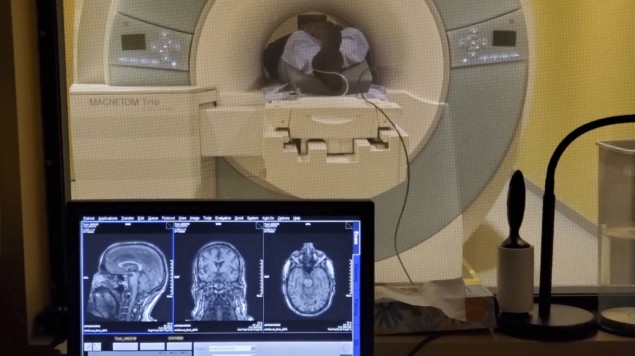
What if exposure to 40 Hz light and sound could promote a healthier brain?
That’s the hypothesis of scientists at The Picower Institute for Learning and Memory at Massachusetts Institute of Technology (MIT).
Gamma band brain rhythms, especially those at 40 Hz, have been associated with large-scale brain network activity, working memory, sensory processing, spatial navigation, attention and more. Research has also shown altered 40 Hz rhythms in patients with Alzheimer’s disease, epilepsy and schizophrenia, says Li-Huei Tsai, a professor at MIT and director of the Picower Institute.
In the late 2000s, a collaboration including Tsai’s lab demonstrated a way of stimulating greater 40 Hz rhythm power in the mouse brain. Tsai’s research group then posited that they could harness 40 Hz stimulation to impact the course of Alzheimer’s disease.
Their initial experiments were successful – 40 Hz stimulation improved gamma rhythm power and synchrony, and reduced amyloid and tau levels (hallmark Alzheimer’s proteins) – but the experiments had used an invasive technology, optogenetics, to fuel 40 Hz power and synchrony.
“MIT colleague and collaborator Emery N Brown suggested that for us to advance a therapy, we would need to find a less invasive method of increasing 40 Hz rhythms,” Tsai says. “Our team tried sensory stimulation in mice, and it worked.”
Subsequent experiments using 40 Hz light and sound exposure not only reduced Alzheimer’s-related pathology but also preserved neurons, synaptic connections, and learning and memory in mice.
Sensory stimulation is based on the concept of neural entrainment, the process by which neural activity phase locks to sensory rhythms and improves various aspects of cognitive processing. The researchers’ first 40 Hz sensory stimulation studies in mice were published in the mid- to late-2010s. Encouraged by the results of that work, they moved on to early-stage clinical studies that tested the safety, feasibility and efficacy of 40 Hz sensory stimulation in humans.
40 Hz sensory stimulation enters clinical trials
The researchers’ latest work, published in PLOS ONE, shares results from the group’s Phase I and IIA clinical studies, which were led by Diane Chan, a neurologist at Massachusetts General Hospital (MGH) and postdoctoral clinical fellow in Tsai’s lab.
Study participants were exposed to 40 Hz stimulation for one hour a day for at least three months using a home-based light panel synchronized with a speaker. Electroencephalogram (EEG) electrodes measured 40 Hz rhythm and synchrony after exposure. The Phase IIA study (which included 15 people with early-stage Alzheimer’s disease) also incorporated follow-up visits, MRI scans of brain volume, cognitive testing and sleep monitoring. Treatment and control groups in the Phase IIA study were matched by age, gender, APOE status and cognitive scores.
Participants reported no serious adverse effects from the 40 Hz stimulation and were over 90% compliant in their use of the home-based equipment. EEG scalp electrode measurements showed significant increases in 40 Hz rhythm power at frontal and occipital sites among cognitively normal participants and volunteers with mild Alzheimer’s disease. The eight phase IIA participants who received the treatment did not experience significant reductions in hippocampal volume or increases in ventricle volume, while controls did. Treated patients also exhibited better connectivity across brain regions involved in cognitive and visual processing networks.
Tsai says the results from these early human trials should be interpreted with cautious optimism. After three months, neither the treatment nor control group showed any differences on most cognitive tests (the treatment group improved only on associating names and faces), but the Phase I and Phase IIA studies were conducted in small cohorts and with limited follow-up due to the COVID-19 pandemic. The group’s studies in mice had demonstrated that for cognitive and benefits to be long-lasting, 40 Hz sensory stimulation should be delivered chronically (consistently over a long period of time).
“[Our] results are not sufficient evidence of efficacy, but we believe they clearly support proceeding with more extensive study of 40 Hz sensory stimulation as a potential non-invasive therapeutic for Alzheimer’s disease,” Tsai says in an MIT press release.
Cognito Therapeutics, a start-up company founded by Tsai and Ed Boyden, a neurotechnology professor at MIT, is now moving forward with Phase III clinical trials of 40 Hz sensory stimulation.
In another line of research, the Picower Institute group and MGH are launching a study to test whether 40 Hz sensory stimulation might be an effective preventative measure in people at risk for developing Alzheimer’s disease. Another study will test for benefits in individuals with Down syndrome. They are also planning to investigate the use of 40 Hz sensory stimulation in people with Parkinson’s disease and are performing ongoing cell culture experiments to better understand the cellular and molecular basis of 40 Hz stimulation effects.

Hyperbaric oxygen therapy could slow, or even reverse, Alzheimer’s disease pathology
Tsai says that this research is a testament to curiosity-driven science and she’s encouraged to see other researchers testing non-invasive 40 Hz stimulation as a potential therapy for Alzheimer’s disease and publishing the results of their own studies.
“Our original experiments in 2009 enhancing 40 Hz rhythms were purely curiosity-driven and not conducted with a clinical endpoint in mind,” Tsai explains. “The story of all that has transpired in this research programme since then might turn out to illustrate, yet again, that basic, curiosity-driven scientific research can produce important, societally beneficial, practical results.”



